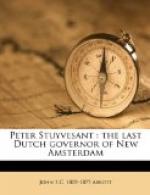A proclamation was issued prohibiting all persons, under penalty of banishment and the confiscation of goods, from harboring the outlaws. Every third man was detailed to act as a minute man whenever required; and the whole population was pledged for the public defence. At the same time, to prevent any misunderstanding, messengers were sent to Connecticut to inform the colonial authorities there, that these measures were adopted solely for the protection of their commerce and the punishment of robbery.
In February of this year, a church was organized at Flatbush. Domine Polhemus was chosen pastor, with a salary of six hundred guilders. A cruciform wooden church was erected, sixty feet long and twenty-eight feet wide. This was the first Reformer Dutch Church on Long Island. The Lutherans had now become quite numerous in New Amsterdam. They petitioned for liberty to organize a church. Stuyvesant, a zealous Calvinist, declined, saying that he was bound by his oath to tolerate no other religion openly than the Reformed. In this intolerance he was sustained by the Company in Holland.
Oliver Cromwell now decided to carry the war against Holland into the New World. He sent word to the governors of the New England Colonists that he was about to dispatch war ships to the coasts of America, and he called upon them to give their utmost assistance for gaining the Manhattoes and other places under the power of the Dutch.
Four armed ships were soon crossing the Atlantic. The expedition was entrusted to Major Sedgwick and John Leverett. They were directed to enter some good port in New England, where they were to ascertain whether the colonial governments would join in vindicating the English right and in extirpating the Dutch.
“Being come to the Manhattoes,” wrote secretary Thurlow,
“you shall, by surprise, open force, or otherwise, endeavor to take the place. You have power to give fair quarter in case it be rendered upon summons without opposition. If the Lord give his blessing, you shall not use cruelty to the inhabitants, but encourage those who are willing to remain under the English government, and give liberty to others to transport themselves to Europe.”
Governor Stuyvesant received early intelligence of the projected expedition, and immediately convened his council. The danger was imminent. The Dutch alone could oppose but feeble resistance. The English in the Dutch colony, though they had sworn allegiance, would probably join their countrymen. “To invite them,” Governor Stuyvesant said, “to aid us, would be bringing the Trojan horse within our walls.” After much anxious deliberation, it was decided to enlist a force of seventy men, “silently and without beat of drum,” and to lay in supplies to stand a siege.
The danger roused the spirit of patriotism. The Dutch rallied with great unanimity and, spade in hand, worked heartily on the fortifications. They were all conscious, however, that treason lurked within their walls.




